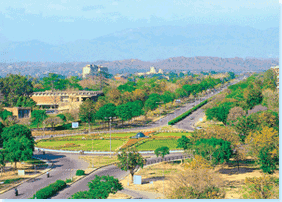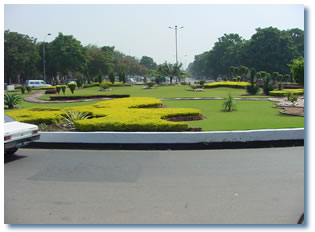Le Corbusier's traffic system followed Mayer's lines but was more elaborate; he called it Les Sept Voies de Circulation, or Seven Vs. The rationale of his planning was the motor car. "From his early studies in urbanism, Le Corbusier had identified the motor car as the central factor of modern town planning. His initial, primarily aesthetic, quasi-Futurist response to the motor car and to rapid movement in the cities had, by 1950, metamorphosed into a theoretical solution to the problems of modern traffic -- a graded system of circulation, from crossing continents to walking to the front door. [As Le Corbusier put it] 'The 7 Vs act in the town plan as the bloodstream, the lymph system and the respiratory system act in biology. These systems are quite rational, they are different from each other, there is no confusion between them, yet they are in harmony ... It is for us to learn from them when we are organising the ground that lies beneath our feet. The 7Vs are no longer the sinister instruments of death, but become an organised hierarchy of roads which can bring modern traffic circulation under control'." [ Prasad Sunand, 1987].

The 7Vs establishes a hierarchy of traffic circulation ranging from : arterial roads (V1), major boulevards (V2) sector definers (V3), shopping streets (V4), neighbourhood streets (V5), access lanes (V6) and pedestrian paths and cycle tracks (V7s and V8s). The essence of his plan for Chandigarh rests on preserving intact the true functions of these seven types of roads.[For details see Le Corbusier's Statue of Land]

The entrance of cars into the sectors, which are exclusively reserved to family life, can take place on four points only; in the middle of the 1,200 meters; in the middle of the 800 meters. All stoppage of circulation shall be prohibited at the four circuses, at the angles of the sectors. The bus stops are provided each time at 200 meters from the circus so as to served the four pedestrian entrances into a sector. Thus the transit traffic takes place out of the sectors; the sectors being surrounded by four wall-bound car roads without openings (the V3s).
The road system was so designed that "never a door will open on the surrounding V3s: precisely the four surrounding V3s must be separated from the sector by a blind wall all along." Buses can ply on the V4s, the horizontal connection between contiguous sectors, but not within the sector interiors. [Evenson, Norma, 1966]







